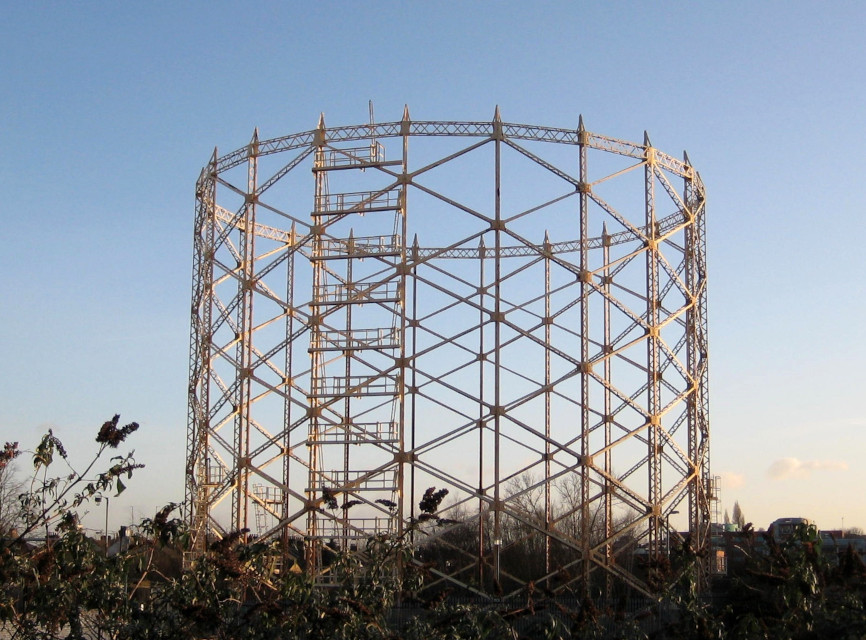Imagine it is 1929 and you are on a train steaming north out of Kings Cross. There is a man in his mid-30s sitting opposite you – he is Barnes Wallis, later to be knighted and famed for his bouncing bombs.
As you pass through Hornsey station he looks out of the window and gazes at the smaller of the two gasholders at Hornsey Gasworks – he smiles at its skeletal structure of repeating triangular shapes.
Those repeating triangular shapes!
Barnes Wallis is travelling to Cardington for a test flight of the airship R100, which he and his team had designed the previous year. One of the innovative things about R100 was surprise, surprise, its structure of repeating triangular shapes! And the Hornsey gasholder, which uses this same structural concept, was built when the great man was only five years old. Perhaps this is fanciful, but Barnes Wallis would certainly have made that journey and, with his engineer’s sense of curiosity, would have taken note of that gasholder.
Hornsey’s historic gasholder
The truth is Gasholder No 1 at Hornsey Gasworks is a remarkable, innovative and historic architectural structure and it is astonishing that it has remained neglected and unsung for so long. It was constructed in 1892 and is the oldest surviving example of ‘Cutler’s Patent Guide Framing’, which enables a structure using a lattice of vertical guides and helical girders to provide the necessary rigidity with a relatively lightweight and strikingly elegant appearance.

Samuel Cutler & Sons of Millwall patented this helical girder concept in 1888. This is not to be confused with conventional rectangular frames with cross-bracing – it is a truly geodesic cylinder. Significantly, it was thirty years in advance of Barnes Wallis coining the term ‘geodesic’ for these light-weight structures for airships and aircraft – and fifty years ahead of Buckminster Fuller’s trendy geodesic domes.
In Norman Foster’s much admired London ‘Gherkin’ which was finished in 2004, over 110 years after the Hornsey design, parallels can be seen in the same helical theme with triangulated lattice patterns. This is a theme again repeated to recent acclaim in the new Hearst Tower in New York, due for completion in 2006. How extraordinary that 21st Century international leading-edge architecture has its unacknowledged precursor in an industrial structure from the 19th Century!
The need for storing coal gas
Also, there are significant historical aspects related to the social and economic development of Hornsey and Wood Green. In 1881 the population of Hornsey was 11,082 and in the 20 years up to 1901 it grew by an additional 61,000. An area that had been characterised by green fields became covered with terraced houses, each requiring gas. London had the world’s first public gas service and the supply companies were well established to meet this huge increase in demand, and were at the forefront in gas production, storage and distribution.
Gasworks and gasholders became common features in Britain’s urban landscape. However, with the introduction of North Sea gas and new technologies, gasholders are fast disappearing. We are now at a point in time when almost all evidence of what was once an important industry, which provided significant local employment, will be lost without trace. Retention of Gasholder No. 1 at Hornsey would be an appropriate reference point to register the historic significance of this industry and its local socio-economic importance.
An additional factor of historic significance is to do with Cutler’s location at Millwall, where it would have been associated with the shipbuilding industry that once flourished there on the south bank of the Thames – an industry that was in terminal decline after 1859 when Brunel’s last ship, the SS Great Eastern, was launched there. Diversification using the same skills and manufacturing technology would have been a natural thing for Cutlers to have done. Preserving the Millwall name of the company at Hornsey would be a fitting reference to London’s rich but mostly lost history as an industrial city.
Why retain Hornsey Gasholder No 1 and what’s the risk?
Well, Haringey has lost much of its heritage buildings and every opportunity should be taken to make the most of the high quality historic assets that remain. Sensitive conservation of Gasholder No 1 could provide a powerful and striking landmark building with historic reference in the proposed Heartlands scheme. The vision here is that the guide frame could form the outer structure of a glass curtain-walled building, as has been done with good effect in Dublin with conversion into luxury apartments.
Haringey Council has deleted Gasholder No 1 from its local list of industrial heritage sites, with a view to its being demolished to make way for Haringey Heartlands Development. At the same time English Heritage is assessing it with a view to its being listed! It’s in the balance and, tragically, could be lost.
Colin Marr
Website editor’s note
In 2012 National Grid received planning permission to redevelop what was called the Clarendon Gasworks on the identified Haringey Heartlands site. The June 2017 Newsletter noted sadly that the two Hornsey gasholders on the site had been demolished in readiness for Haringey Heartlands Regeneration. St William, part of The Berkeley Group, are constructing 1,056 dwellings in tall apartment blocks, calling the development ‘Clarendon’, a city village.